Best Ryobi Table Saw Review
- December 18, 2023
- 0 comment
Discover the top Ryobi table saws in our detailed review. Explore the features, pros, and cons of popular models like RTS12, RTS23, and more to find the ideal saw for your woodworking projects. Perfect for DIYers and pros alike.
When it comes to woodworking, whether you’re a seasoned professional or a DIY enthusiast, the right table saw can be the cornerstone of your workshop. Ryobi, a brand renowned for balancing quality with affordability, offers a range of table saws that cater to a variety of needs and skill levels. In this comprehensive review, we delve into the Best Ryobi Table Saws, exploring the unique features, strengths, and potential limitations of five standout models in their lineup. From compact, space-saving designs to more robust, professional-grade tools, we’ll help you navigate the options to find the perfect Ryobi table saw that aligns with your woodworking dreams and realities.
Best Ryobi Table Saws Summary:
| Model | Blade Diameter | Motor | RATINGS |
|---|---|---|---|
 | 10 in. | 15 Amp, 120V | ★★★★★ |
 | 10 in. | 15 Amp, 120V | ★★★★☆ |
 | 8-1/4 in. | 13 Amp, 120V | ★★★★☆ |
What is a Table Saw?
A table saw, known in England as a sawbench or bench saw, is a vital woodworking tool featuring a circular saw blade mounted on an arbor and powered by an electric motor, which can be connected directly or via belt, cable, or gears. This assembly is situated under a sturdy table that supports the material, typically wood, being cut, with the blade projecting upwards through a slot in the table. Modern table saws usually have a fixed table and an adjustable blade, allowing users to alter the cut’s depth by adjusting the blade’s protrusion above the table. Many models also offer a tilting blade to change the angle of the cut, enhancing the saw’s versatility and precision, a significant advancement over older designs where the table itself was adjusted for height and angle.
Ryobi Table Saw Top Picks
1. Ryobi 10 in. Table Saw with Folding Stand (RTS12)
Specifications
| No Load Speed | 5,000 RPM |
| Motor | 15 Amp, 120V |
| Rip Capacity Left | 7 in. left of blade |
| Rip Capacity Right | 12 in. right of blade |
| Dado Width | 1/2 in. (with dado throat plate, not included) |
| Cut at 45° | Depth of cut: 2-1/2 in. |
| Cut at 90° | Depth of cut: 3 in. |
| Blade Diameter | 10 in. |
The Ryobi RTS12 is a testament to functionality and convenience, making it a top pick for DIY enthusiasts. This 10-inch table saw is a beacon of portability, thanks to its folding stand, which makes storage and transportation a breeze. Ideal for small to medium projects, it offers a blend of simplicity and effectiveness, with an adjustable miter gauge that enhances precision. The moderate power of the motor ensures it can handle a variety of woods, though it may not be the go-to for very heavy-duty tasks.
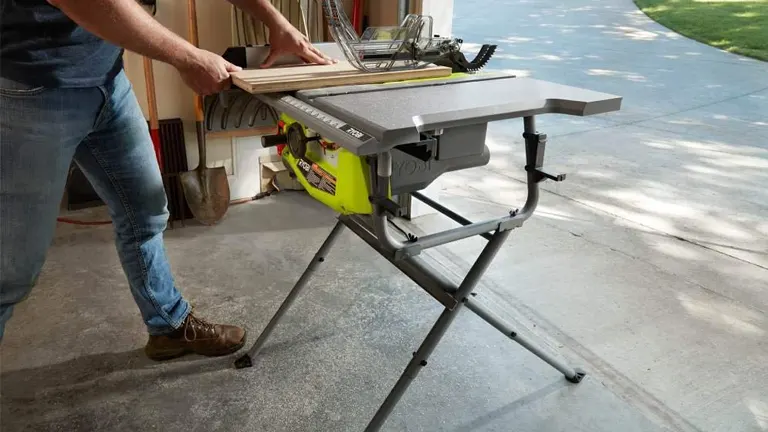
While it excels in user-friendliness, the RTS12 might not satisfy professionals looking for high-end power and cutting capacity. However, for hobbyists or those with limited space, it strikes a near-perfect balance between size, functionality, and affordability. Its ease of setup and intuitive design make it an excellent entry-level table saw for users who need reliable performance without the complexities of more professional models.
Things I Liked
- The folding stand makes it easy to store and transport.
- Ideal for beginners, with a simple setup and operation.
- Suitable for a variety of small to medium projects.
Things I Didn’t Like
- May struggle with very heavy-duty tasks.
- While portable, the stand isn’t as robust as fixed models.
2. Ryobi 10 in. Table Saw with Steel Stand (RTS23)
Specifications
| No Load Speed | 5,000 RPM |
| Motor | 15 Amp, 120V |
| Rip Capacity Left | 7 in. left of blade |
| Rip Capacity Right | 27 in. right of blade |
| Dado Width | 1/2 in. (with dado throat plate, not included) |
| Depth of Cut at 45° | 2-1/2 in. |
| Depth of Cut at 90° | 3 in. |
The RTS23 is a step up in the Ryobi table saw lineup, offering greater stability and power. Its steel stand is not just about robustness but also about providing a solid foundation for more accurate cuts. The 10-inch blade is standard, but the enhanced ripping capacity and more potent motor make it suitable for larger and more demanding projects. This model is a great middle ground for those who find the RTS12 too basic but don’t need the full capabilities of professional-grade saws.
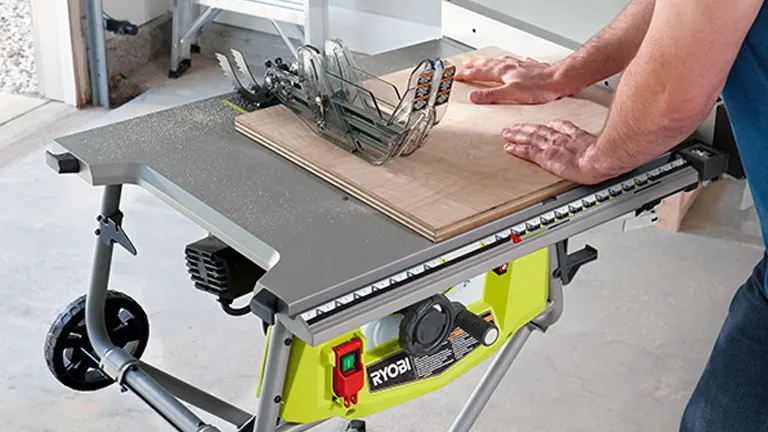
However, the added sturdiness of the RTS23 comes at the cost of portability. While still manageable, it’s less convenient to move around compared to the RTS12. This model is ideal for serious DIYers or semi-professionals who require a reliable table saw for frequent use. Its ability to handle a variety of materials with precision makes it a valuable addition to any workshop.
Things I Liked
- The steel stand provides a solid base for accurate cuts.
- Capable of handling larger, more demanding projects.
- Feels sturdy and durable for frequent use.
Things I Didn’t Like
- Heavier and less convenient to move compared to lighter models.
- Requires more storage space, not ideal for very compact areas.
3. Ryobi 8-1/4 in. Table Saw (RTS08)
Specifications
| Rip Capacity Right | 12-1/2 in. right of blade |
| Rip Capacity Left | 7 in. left of blade |
| Depth of Cut at 45° | 1-5/8 in. |
| Depth of Cut at 90° | 2.2 in. |
| No Load Speed | Up to 5,700 RPM |
| Motor | 13 Amp, 120V |
| Blade Diameter | 8-1/4 in. |
Compact and efficient, the Ryobi RTS08 is the quintessential table saw for small-scale projects and limited spaces. Its 8-1/4 inch blade is smaller than its counterparts, but it’s precisely this size that makes it incredibly suitable for easy storage and maneuverability. This model is tailored for users who need to perform light cutting tasks and prioritize space-saving and simplicity over extensive cutting capabilities.
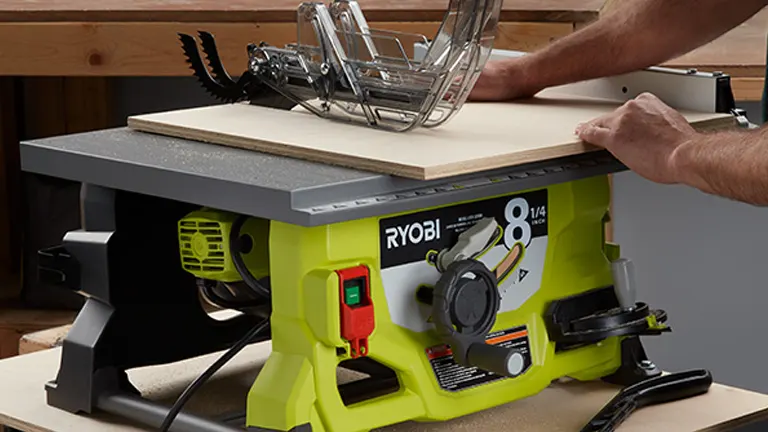
While the RTS08 won’t satisfy the needs of those undertaking large-scale projects, its niche lies in its minimal footprint and ease of use. It’s an excellent choice for beginners or as a secondary saw for quick, uncomplicated cuts. The lower power output aligns well with its intended use for thinner materials and less frequent cutting tasks, making it a solid choice for occasional DIY work.
Things I Liked
- Great for small spaces and easy to store.
- It is ideal for occasional use and is easy to move.
- Straightforward for beginners and casual users.
Things I Didn’t Like
- Not suitable for large or thick materials.
- May not be adequate for more intensive tasks.
Ryobi Buyer’s Guide: Choosing the Right Table Saw
Before diving into the specifications, it’s important to assess your requirements. Consider the types of projects you’ll be undertaking, the materials you’ll be working with, and the frequency of use. This will help you determine the size, power, and features you need.
- Assessing Power and Motor
- Amperage: Ryobi saws typically range from 13 to 15 amps. Higher amperage means more cutting power.
- Motor Type: Most Ryobi saws use brushed motors, known for reliability and sufficient power for most DIY projects.
- Blade Size and Types
- Standard Sizes: Most Ryobi table saws come with 10-inch blades, ideal for various cuts. Some models offer smaller blades for more specific tasks.
- Blade Types: Ensure the saw can accommodate different blade types if you plan to cut various materials.
- Cutting Capacities and Adjustments:
- Depth of Cut: Look at the maximum depth of cut at both 90° and 45° angles. This determines how thick of a material you can cut.
- Rip Capacity: This is how wide a material the saw can handle. Larger rip capacities allow for more versatility.
- Portability and Size:
- Compact Models: Ideal for limited spaces or occasional use. They are easier to store and transport.
- Models with Stands: Offer stability and are suitable for more frequent use. Consider if the stand is fixed or rolling, depending on your mobility needs.
- Safety Features:
- Look for features like blade guards, riving knives, and anti-kickback pawls. Safety should always be a priority.
- Additional Features:
- Dust Collection: Essential for keeping your workspace clean and reducing health hazards.
- Accessory Storage: Some models offer onboard storage for tools and accessories.
- Ease of Assembly: Consider how easy it is to set up and adjust the saw.
- Budget and Warranty:
- Ryobi offers a range of prices to fit different budgets. Always check the warranty and customer support options.
- User Reviews and Brand Reputation:
- Reading user reviews can provide practical insights into a saw’s performance and durability. Ryobi is generally well-regarded for its balance of cost and quality.
FAQs
- What Makes Ryobi Table Saws Stand Out in the Market?
Learn about the unique features and benefits that set Ryobi table saws apart from other brands, including their balance of affordability, reliability, and user-friendly designs. - How Do I Choose the Right Ryobi Table Saw for My Needs?
Get insights on selecting the perfect Ryobi table saw based on your specific woodworking projects, space considerations, and budget. - What Safety Features Do Ryobi Table Saws Offer?
Understand the safety mechanisms integrated into Ryobi table saws, such as blade guards, riving knives, and anti-kickback pawls, and how they contribute to a safer woodworking environment. - Can Ryobi Table Saws Handle Heavy-Duty Projects?
Explore the capabilities and limitations of Ryobi table saws in handling various project sizes, from light DIY tasks to more demanding woodworking endeavors. - What Maintenance is Required for a Ryobi Table Saw?
Find out about the regular maintenance practices needed to keep your Ryobi table saw in optimal condition, including cleaning, blade changing, and lubrication. - Are There Compatible Accessories Available for Ryobi Table Saws?
Discover the range of accessories available for Ryobi table saws, such as stands, dado blade sets, and extension tables, to enhance their functionality and versatility. - How Does the Warranty Work for Ryobi Table Saws?
Get information on the warranty coverage for Ryobi table saws, what it includes, how long it lasts, and how to claim it in case of any issues. - What Are the Differences Between Corded and Cordless Ryobi Table Saws?
Learn the pros and cons of corded versus cordless Ryobi table saw models to determine which type best suits your workshop setup and project needs.

David Murray
Forestry AuthorI'm David Murry, a forestry equipment specialist with a focus on chainsaw operation. With over 13 years of experience, I've honed my skills in operating and maintaining a wide range of machinery, from chainsaws to log splitters. My passion for the outdoors and commitment to sustainable forestry drive my work, which emphasizes safety, efficiency, and staying updated with industry advancements. Additionally, I'm dedicated to sharing my expertise and promoting environmental awareness within the forestry community.

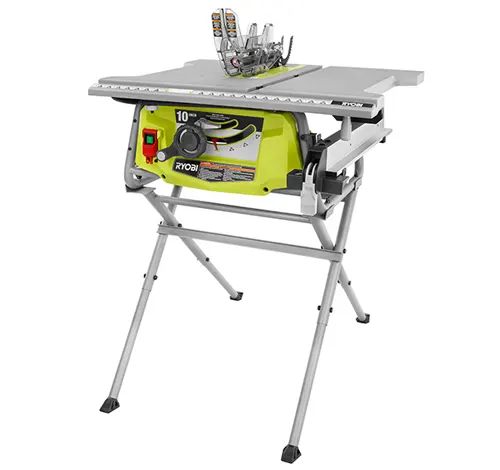

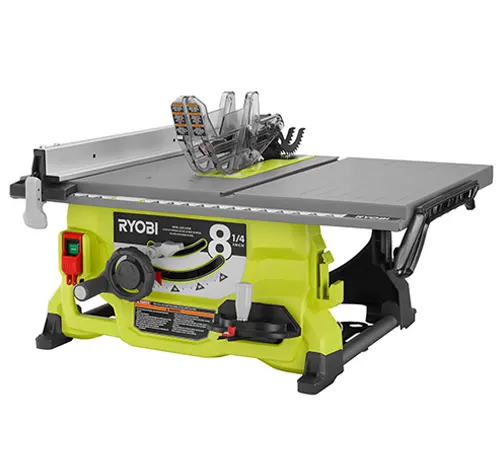












Leave your comment